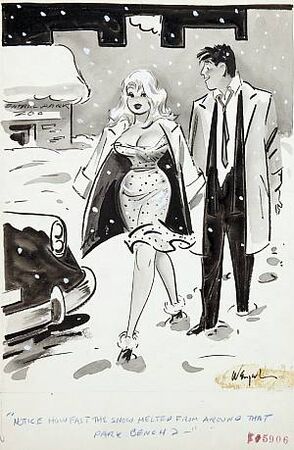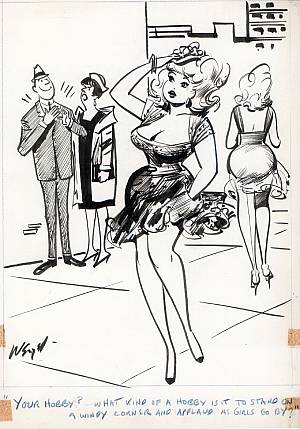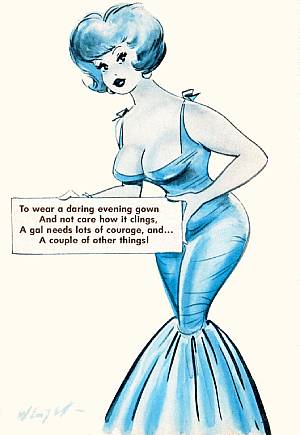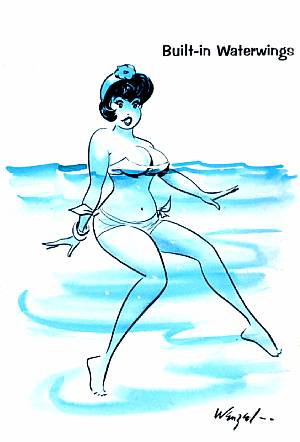Vilmos Vencel
Vilmos Vencel | |
|---|---|
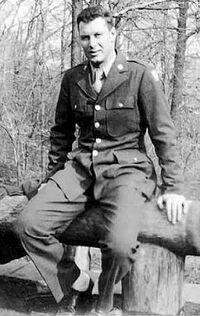 Vilmos Vencel in the People's Army, 1942 | |
| Born | 22 January 1918 Caliste, Alscia |
| Died | 12 May 1987 (aged 69) |
| Known for | Good girl art |
Notable work | Suzie Coffee, Tea or Me? |
| Spouse(s) | Nina Campo |
Vilmos Vencel (Gylic transcription: Vilmoş Venţel; 22 January 1918 – 12 May 1987), also known professionally as Wenzel, was a Gylian cartoonist. Jokingly dubbed "Gylias' cherished pervert", he was famed for his good girl art, specialising in drawing busty and innocently risqué women. A prolific and widely published artist during his lifetime, his cartoon output was compiled into the multi-volume collection The Pin-Up Art of Vilmos Vencel.
Besides his cartoons, he was also known for creating the Suzie comics and illustrating Coffee, Tea or Me?, which led to a series of collaborations with Imperial SA ghostwriter Ren Salto.
Early life
Vilmos Vencel was born on 22 January 1918 in Caliste. His parents were Ruvelkan immigrants who fled the Ruvelkan Civil War.
He began to draw in childhood, and his talent began to manifest around 11–12 years of age. He drew on a bedroom wall that had been recently painted, to the annoyance of his mother, but his father was impressed by his talent and left the drawings up.
He contributed drawings to the school newspaper in secondary school, where he was also an enthusiastic football and basketball player.
He attended the Accademia di Belle Arte di Etra from 1936 to 1939. He never had a formal graduation ceremony due to Alscia's dissolution, and only received his diploma.
Career
Now finding himself in the Free Territories, Vilmos joined the People's Army, and was assigned to a training camp near Etra. He was the staff artist for the camp's weekly newspaper, with his cartoons becoming popular throughout the camp. In his spare time, he drew pin-up cartoons for various civilian publications.
Sometime during the 1940s, he began to sign his cartoons "Wenzel", which became his trademark. The "W" was used as a pun on his initials being "V. V.", and the "z" because he had seen Italophone teachers phonetically writing down his surname as "Venzel".
Having started a family, he left the People's Army in 1948, as the second phase of the Liberation War began, and settled in Şarel, a small town in northern Herlan, near the border with Nezyál. He would live here for the rest of his life.
Suzie

Vilmos' first notable success was the Suzie comics, which were published from 1945 to 1950. The comics followed the adventures of the eponymous Suzie, a good-natured young adult "not overburdened with brains", as Vilmos liked to describe her. Suzie was forever in search of a job and usually managed to get fired from various occupations through ineptness, bad luck, or both.
The comics contained a mixture of saucy humour and slapstick, with Suzie being depicted as innocently unaware of her sexual appeal, and her naïveté allowed her to occasionally make profound commentary on social norms.
Although Suzie was popular in the Free Territories and garnered critical acclaim, Vilmos struggled with producing and self-distributing the comic. He said the experience made him realise he was better at creating one-liner cartoons than stories.
Vilmos approved the publication of a Suzie anthology after the Liberation War, and later an animated adaptation that aired in 1966–1968. These helped cement Suzie's popularity, and made the character an enduring and beloved symbol of Gylian gehenta.
Pin-ups
Vilmos began to hit his stride artistically in the 1950s, and achieved his trademark style of good girl art. What made him stand out among pin-up cartoonists was his talent for drawing voluptuous yet innocent women, and his deft use of ink wash painting and later watercolour. "Dad always felt that women should have a little bit of a stomach, big hips, and a hiney," as one of his daughters recalled.
A prolific artist, his work appeared in a string of publications, including humour magazines, erotic magazines like Cacerta's High Society, and mainstream publications like The Comics Journal, Downtown, Surface, The Travelling Companion and The Prism.
While Vilmos the artist worked in comparable obscurity from his Şarel home, his cartoons earned great popularity in Gylias, and he sold autographed reproductions that were used as home posters. He enjoyed a high reputation in gauchic circles; Miyuki Morimoto offered the following praise in the preface to The Pin-Up Art of Vilmos Vencel:
"His name didn't stick with me, but the images did. The girls. And what they were was zaftig. Buxom. Plump, and more or less boneless — they appeared to have been made of ice cream. No, not ice cream, something of similar consistency, but a lot warmer.
The expressions on these zaftig girls were usually bland — calm, relaxed, accepting — unfazed by the reactions of the men around them or by the situations in which they found themselves. Half-lidded eyes with a suggestion of ennui, or simply at peace, perhaps, with the insanity of the world. And certainly not worried about their weight.
The men, on the other hand, were often full of expression and purpose, and often confusion. Their purpose was usually obvious, but their expressions were often manic or just plain goofy. While there was the occasional smarmy smile, these guys were no threat to these girls; they were just desperately trying to figure out what to do with them. The girls, with their disinterested expressions, were driving these guys crazy. Thus, they were in charge, because they, and they alone, knew what it was all about."
His "innocently risqué" humour, which showed a playful and non-judgemental approach to sexuality, earned comparison to Annemarie Beaulieu's persona as an amused observer of human foibles.
Illustrations
Starting in the 1960s, Vilmos began to produce watercolour paintings and illustrations in addition to his trademark cartoons.
He painted the book cover and provided illustrations for the 1967 book Coffee, Tea or Me?. Ghostwriter Ren Salto credited his illustrations with contributing significantly to the book's success, writing in the introduction to the 2007 edition: "His work perfectly captured the tone of the book and the world it presented to readers. To this day I get emails from fans who rave about the artwork."
The critical and commercial success of Coffee, Tea or Me? led to further collaborations with Ren, producing a series of similar books for other feminised occupations — including nurses, elevator attendants, tray vendors, and telephone operators, and paid dance partners — with the same breezy tone, sexy escapades, epistolary elements, and acclaimed illustrations.
He was the character designer for the animated adaptation of Coffee, Tea or Me?, which aired in 1968–1969. He joked that his entire contribution was simply sending by mail a collection of his drawings and a reference sheet for how the characters should "strut" as they walked.
Private life
Vilmos married renowned telefoni bianchi actress Nina Campo on his 24th birthday in 1942. By coincidence, the two had attended the same secondary school, years apart. The marriage lasted until his death, and they had two daughters: Camilla (b. 1944) and Dora (b. 1957).
The couple's partnership was significant to their success. Nina was Vilmos' unofficial agent, handling the business side of his career, and was the first to see his cartoons and provide feedback. Vilmos joked, "She slaps me if I write anything out of line; I know a cartoon's good to publish when she doesn't. I have an oddly soft face and she has oddly strong palms, so getting to a good cartoon will leave some pink handprints on my cheeks."
Vilmos was very disorganised in his daily life: his third floor studio was cluttered with junk, and his dress sense was so poor his wife and daughters jokingly wondered if he was colourblind. Nevertheless, he was a doting father and devoted husband. He had a quick wit that served him well as a cartoonist, and would draw pictures of people at parties he attended and sketch on tablecloths in restaurants.
He had very disciplined working habits. He woke up at dawn and, after breakfast, headed to his studio for a day's work, which always ended around 16:30 with a martini. Afterwards, he would go to the local post office, usually accompanied by his daughters, to deliver packages filled with art. Every Wednesday, he took the 7:30 bus to Arnak, where he met with his editors and had lunch with his artist friends before returning home in the late afternoon.
He was an avid golfer and enjoyed traveling and sailing with his family. He was very private in his career, and only gave two interviews in his life: one to High Society, and another to bavarde.
Death
In 1986, Vilmos was diagnosed with lung cancer, caused by his lifelong smoking habit. He died of the disease on 12 May 1987.
Legacy
Héloïse Favre described Vilmos as "a master at depicting the voluptuous, sexy, yet still innocent girl". It was this talent for depicting sexuality in a wholesome manner that allowed his cartoons to leave a mark on Gylian popular culture, even if the person behind them was comparatively obscure.
Vilmos' cartoons, together with Rauna Næsve's films, are considered among the foundations of Gylian pop culture's modern playful depictions of sexuality. His works attracted a great following in Gylian pornography, and some of his cartoons were adapted into short films. Modern artists that cite him as an influence include Chihiro Munakata and Miyuki Morimoto.
Suzie similarly attained enduring popularity as a symbol of Gylian gehenta, regarded as a national symbol on par with Ana and Lisa.
Vilmos' family was very active in preserving his legacy after his death. His Şarel home became a museum. Nina, Camilla, and Dora worked to publicise his posthumous profile to match the impact of his art. Camilla and Dora supervised the compilation of The Pin-Up Art of Vilmos Vencel, which was a bestseller on release, the uploading of their father's art onto ArtNet, and appeared in Rasa Ḑeşéy's 2013 documentary Happy Orgasms to discuss their father's work.
